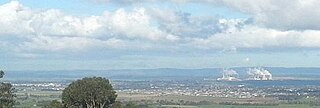
Traralgon is a city located in the east of the Latrobe Valley in the Gippsland region of Victoria, Australia and the most populous city in the City of Latrobe and the region. The urban population of Traralgon at the 2021 census was 26,907. It is the largest and fastest growing city in the greater Latrobe Valley area, which has a population of 77,168 at the 2021 Census and is administered by the City of Latrobe.

Morwell is a town in the Latrobe Valley area of Gippsland, in South-Eastern Victoria, Australia approximately 152 km (94 mi) east of Melbourne.

The Latrobe Valley is an inland geographical district and urban area of the Gippsland region in the state of Victoria, Australia. The traditional owners are the Brayakaulung of the Gunai nation. The district lies east of Melbourne and nestled between the Strzelecki Ranges to the south and the Baw Baw Ranges, part of the Great Dividing Range, to the north. Mount St Phillack is the highest peak to the north of the Latrobe Valley, due north of Moe. The highest peak to the south is Mt Tassie, south of Traralgon.

The Shire of Baw Baw is a local government area in Victoria, Australia, in the eastern part of the state. It covers an area of 4,028 square kilometres (1,555 sq mi) and in 2021 had a population of 57,626.

Pakenham is a suburb of Melbourne in Victoria, Australia, 53 km (33 mi) south-east of Melbourne's Central Business District and the most populous in the Shire of Cardinia. Pakenham recorded a population of 54,118 at the 2021 census.

Longwarry railway station is a regional railway station on the Gippsland line, part of the Victorian railway network. It serves the town of Longwarry, in Victoria, Australia. Longwarry station is a ground level unstaffed station, featuring one side platform. It opened on 1 July 1881.

Drouin railway station is a regional railway station on the Gippsland line, part of the Victorian railway network. It serves the town of Drouin, in Victoria, Australia. Drouin station is a ground level unstaffed station, featuring an island platform with two faces. It opened on 1 March 1878.

Warragul railway station is a regional railway station on the Gippsland line, part of the Victorian railway network. It serves the town of Warragul, in Victoria, Australia. Warragul station is a ground level premium station, featuring one side platform. It opened on 1 March 1878, with the current station provided in 2015.
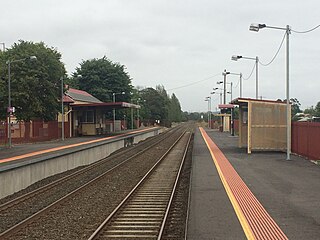
Yarragon railway station is a regional railway station on the Gippsland line, part of the Victorian railway network. It serves the town of Yarragon, in Victoria, Australia. Yarragon station is a ground level unstaffed station, featuring two side platforms. It opened on 1 August 1878.
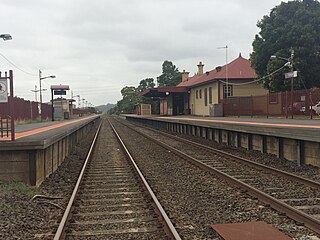
Trafalgar railway station is a regional railway station on the Gippsland line, part of the Victorian railway network. It serves the town of Trafalgar, in Victoria, Australia. Trafalgar station is a ground level unstaffed station, featuring two side platforms. It opened on 1 August 1878.

Moe railway station is a regional railway station on the Gippsland line, part of the Victorian railway network. It serves the town of Moe, in Victoria, Australia. Moe station is a ground level unstaffed station, featuring an island platform with two faces. It opened on 1 March 1878.

Trafalgar is a town in the West Gippsland region of Victoria, Australia. The town lies on the Princes Highway and main Gippsland railway line about 10 kilometres (6 mi) west of Moe. The town backs onto the foothills of the Strzelecki Ranges to the south. The township sits at approximately 70 metres above sea level. At the 2016 census, Trafalgar had a population of 3,912. The town is named in honour of the Battle of Trafalgar, 1805, which established the Royal Navy's supremacy at sea; allowing consolidation of Britain's Australian colonies at the time.

Drouin is a town in the West Gippsland region, 90 kilometres (56 mi) east of Melbourne, in the Australian state of Victoria. Its local government area is the Shire of Baw Baw, and is home to the shire council's headquarters despite being the second-largest town in the shire, behind neighbouring Warragul. The town's name is believed to be derived from an Aboriginal word meaning "north wind". New housing developments have accelerated the town's residential growth in recent years. As at the 2016 census, Drouin had a population of 11,887 people.

Moe is a town in the Latrobe Valley in the Gippsland region of Victoria, Australia. It is approximately 130 kilometres east of the central business district of Melbourne, 45 kilometres due south of the peak of Mount Baw Baw in the Great Dividing Range and features views of the Baw Baw Ranges to the north and Strzelecki Ranges to the south.

Yarragon is a town in the Shire of Baw Baw in the West Gippsland region of Victoria, Australia. The town lies on the Princes Highway and the Gippsland railway line approximately halfway between the major towns of Warragul and Moe. Hills of the Strzelecki Ranges rise over 500 metres (1,600 ft) immediately to the south of the town, providing a spectacular backdrop, while the Moe River and the lowlands lie to the north and east. Mount Worth at 515 m (1,690 ft) above sea level is the highest near peak to the south in the Mount Worth State Park 16 kilometres (9.9 mi) SSW of Yarragon. Mount Baw Baw at 1,563 m (5,128 ft) in the Baw Baw Ranges as part of the Great Dividing Range to the north is approximately 85 kilometres (53 mi) NNE of Yarragon. The township sits at approximately 88 metres (289 ft) above sea level. At the 2006 census, Yarragon had a population of 1131.

Neerim South is a town in West Gippsland, Victoria, Australia, located in the Shire of Baw Baw, 110 kilometres (68 mi) east of Melbourne and 20 kilometres (12 mi) north of Warragul. At the 2021 census, Neerim South had a population of 1,599.
Willow Grove is a town and rural farming community located in the Baw Baw foothills. It is northwest of Moe in Victoria, Australia and North of Trafalgar. It has a primary school, football club, tennis courts, community hall, general store, CFA shed, and kindergarten. It is a popular tourist destination where people can enjoy trail bike riding, camping, four wheel driving & hunting. The next town to the west is Hill End and to the east Tanjil South. Willow Grove is situated within the Shire of Baw Baw and shares the postcode 3825. At the 2006 census, Willow Grove and the surrounding area had a population of 221.
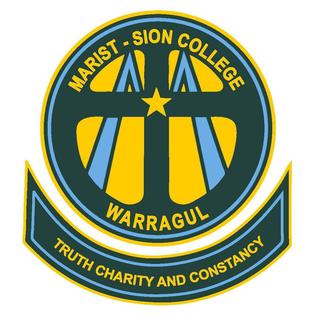
Marist-Sion College is a co-educational Roman Catholic independent school founded in 1975 and located in Warragul, Victoria, Australia.
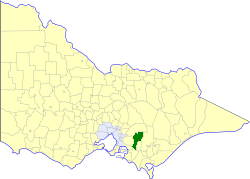
The Shire of Buln Buln was a local government area about 95 kilometres (59 mi) east-southeast of Melbourne, the state capital of Victoria, Australia. The shire covered an area of 1,259 square kilometres (486.1 sq mi), and existed from 1878 until 1994.
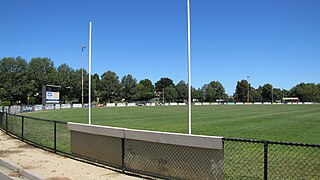
Western Park is a recreation reserve on the western side of the West Gippsland town of Warragul, Victoria.






















